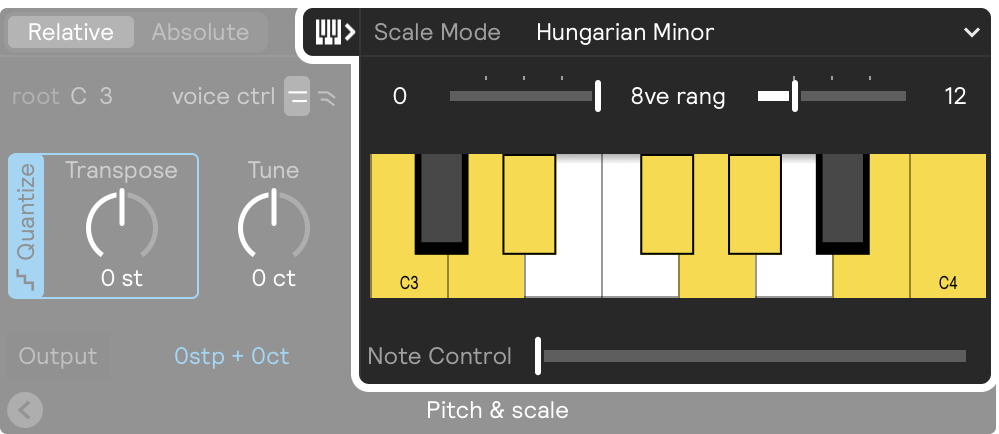Pitch & Scale

The Pitch & Scale panel is a powerful tool that allows you to control melody to your samplers and modules.
When the scale mode panel is closed, you can see the parameters: Transpose, Quantize,Tune, Relative/Absolute, root, voice cntrl and the Output meter.
The Transpose knob allows you to change the pitch of the entire module and all of its submodules. When Quantize is on, the Transpose knob will snap to the nearest halfstep or semitone (keeping to the chromatic scale). The Tune knob allows you to change the pitch in Cents, which are 1/100th of a semitone. This is useful for fine-tuning the pitch of a module or achieving non-western tunings with quartertones.
When in Relative mode, the Output meter will display the output of the module in steps + cents, and maintain note messages sent from Note Controllers or MIDI input.
When in Absolute mode, the root parameter is engaged and set to C3 automatically (this can be changed to reflect the actual notes of the audio files inside the samplers) . When in Absolute mode, the Output will now display the actual note being output by this module.
voice cntrl allows you to set the behavior of the tails of a repitched sampler. If set to “Next,” then no voices slide, if set to “All,” then all voices slide. This parameter is only relevant if you have an assignment on Transpose, Tune, or Note Control (more on Note Control below).

When you open up the scale mode, a keyboard appears where you can select and deselect notes. You can also select a scale from the Scale Mode dropdown. The notes/scale selected really only come into play if you have an assignment or modulator mapped to Note Control.
The assignment or modulator you’ve mapped to Note Control will govern the melody of the module. For example, if you select the Hungarian Minor scale from the Scale Mode dropdown, and then map velocity to Note Control: your range of quiet to loud hits will trigger C, D, Eb, F#, G, Ab, B, C (assuming your samples are tuned to C and you have not altered the 8ve range).
You can set the top and bottom range of the scale’s quantization by adjusting the sliders to the left and right of 8ve range, by default they are set to 0 and 12, which means there is a one octave range selected by default.